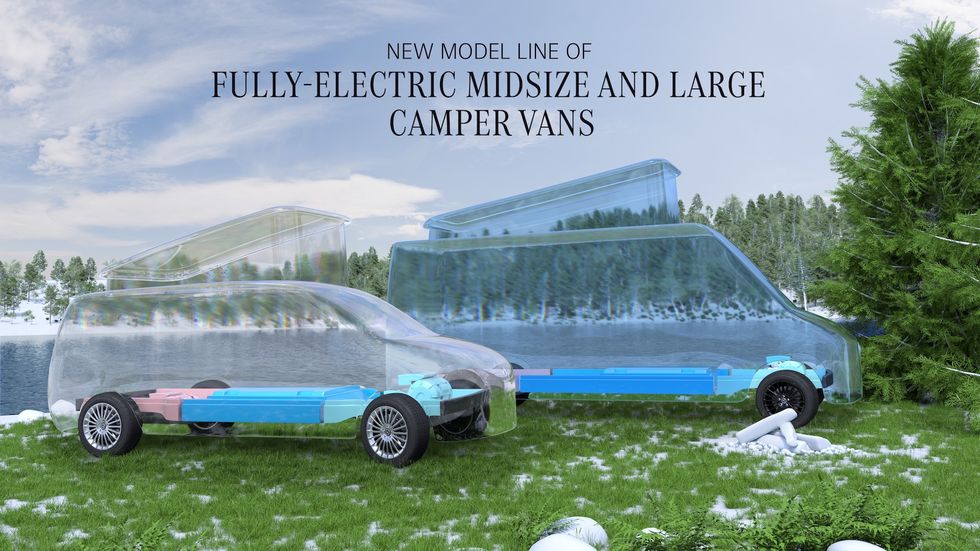Mercedes-Benz's VAN.EA Platform Will Underpin New Vans Starting In 2026

Mercedes-Benz’s VAN.EA platform will underpin all newly developed commercial and privately owned vans starting in 2026. The electric architecture is modular and scalable, allowing front- or all-wheel drive as well as different battery capacities and wheelbases.An unnamed mid-size luxury van based on the VAN.EA platform is also destined for the U.S. market.
Big changes are coming to Mercedes-Benz’s family of commercial and privately owned vans. Starting in 2026, the company has announced that all newly developed models will be built on a modular, scalable electric architecture called VAN.EA.
New #VanLife
While Mercedes says there will still be a clear distinction between future vans that are designed for commercial use and those that are designed for personal use, all of them will use the singular VAN.EA platform that can be configured in myriad ways (as seen below). Previously, this wasn’t possible with the mid-size Metris and larger Sprinter vans.
Mercedes-Benz
All future electric Mercedes vans using VAN.EA will feature a standardized front module with an electric motor powering the front wheels. A center module can be stretched to accommodate different battery sizes and wheelbase lengths. A rear module can be configured with or without an electric motor feeding the rear axle, depending on whether the van has front- or all-wheel drive.
U.S. Influence
Mercedes says it has already seen significant growth in the U.S. market, claiming its market share has jumped from 8 percent in 2018 to 16 percent in 2022. The company expects to build on that with VAN.EA, not only with its upcoming commercial variants, but also with a new mid-size luxury van that’s coming to America.
This new van doesn’t yet have an official name, but Mathias Geisen, head of Mercedes-Benz Vans, says it won’t use the Metris nameplate. Instead, it’ll look entirely different and will be one of the first to launch when the new vans start reaching our shores sometime in 2026. Mercedes also says it’ll introduce a new line of camper vans based on the VAN.EA platform.

Mercedes-Benz
In conjunction with the VAN.EA platform, the company is developing a new operating system called MB.OS. Along with allowing faster over-the-air (OTA) software updates, the system is expected to allow greater access to digital services and a wider variety of third-party apps. Mercedes is also working to expand its automated-driving technology, starting with SAE Level 2. By the end of the decade, automation is expected to reach Level 3 for privately owned models and Level 4 for commercial vans.
What About ICE Vans?
Mercedes hasn’t released any specific details about VAN.EA powertrain output, available battery capacities, or range estimates. However, the 2024 Mercedes-Benz eSprinter—which isn’t based on the VAN.EA platform but is slated to go on sale in the U.S. later this year—is claimed to have traveled 275 miles from Las Vegas, Nevada, to Long Beach, California, on a single charge. That distance was reached while using a 113.0-kWh battery pack.
Although the new eSprinter will eventually be replaced by a VAN.EA version, Mercedes says that its existing vans with an internal-combustion engine will remain on sale throughout the decade. As long as there is demand or them, there’s no end date.
Electric Mercedes-Benz Vans
This content is imported from poll. You may be able to find the same content in another format, or you may be able to find more information, at their web site.

Senior Editor
Eric Stafford’s automobile addiction began before he could walk, and it has fueled his passion to write news, reviews, and more for Car and Driver since 2016. His aspiration growing up was to become a millionaire with a Jay Leno–like car collection. Apparently, getting rich is harder than social-media influencers make it seem, so he avoided financial success entirely to become an automotive journalist and drive new cars for a living. After earning a degree at Central Michigan University and working at a daily newspaper, the years of basically burning money on failed project cars and lemon-flavored jalopies finally paid off when Car and Driver hired him. His garage currently includes a 2010 Acura RDX, a manual ’97 Chevy Camaro Z/28, and a ’90 Honda CRX Si.







